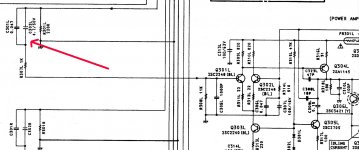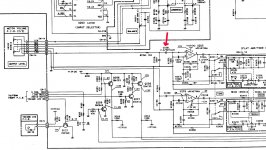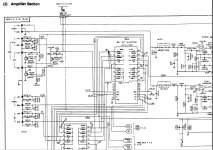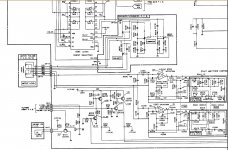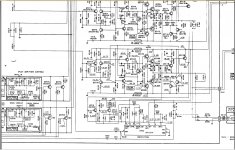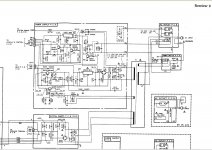Split from another thread I started about general info regarding possible cap 'upgrades' in other equipment..
I have (my pride and joy) a nakamichi RE2 receiver.
The time has come to do a full recap.
I am wondering if anyone has any pearls of wisdom about any potential items that may result in sonic improvements for this model..
I believe it is based on the previous 'Receiver two'.
As part of the make over I will also replace the trimpots with multi turn and install better speaker posts.
The speaker posts not for any sonic benefit, but more cause the originals are, rubbish 🙂
At this stage I am looking at replacing two signal/series electros with foil/film.
And all other electros with panasonic FR's.
Research says that the pana FM's are better sonicly than the FC's.
And the FR's are a newer version of the FM's in a larger range and have a much longer service life.
So, please, tell me your thoughts............
I have (my pride and joy) a nakamichi RE2 receiver.
The time has come to do a full recap.
I am wondering if anyone has any pearls of wisdom about any potential items that may result in sonic improvements for this model..
I believe it is based on the previous 'Receiver two'.
As part of the make over I will also replace the trimpots with multi turn and install better speaker posts.
The speaker posts not for any sonic benefit, but more cause the originals are, rubbish 🙂
At this stage I am looking at replacing two signal/series electros with foil/film.
And all other electros with panasonic FR's.
Research says that the pana FM's are better sonicly than the FC's.
And the FR's are a newer version of the FM's in a larger range and have a much longer service life.
So, please, tell me your thoughts............
Attachments
Owning one of these myself, one real annoyance I'd change -and will- would be the switching on the tape monitor input. It isn't a real tape monitor input. It's a separate input like a CD or Aux input.
The other great annoyance is which side of the rear pre-amp in/out connectors the main volume control is on. It's located on the output side. From my perspective it should be on the input side, giving main volume control over power amp when using external graphic equaliser.
It is a great sounding receiver, but for a company that was such a paragon in the magnetic tape world they really dropped the ball on the controls on this receiver.
Doc
The other great annoyance is which side of the rear pre-amp in/out connectors the main volume control is on. It's located on the output side. From my perspective it should be on the input side, giving main volume control over power amp when using external graphic equaliser.
It is a great sounding receiver, but for a company that was such a paragon in the magnetic tape world they really dropped the ball on the controls on this receiver.
Doc
Last edited:
TBH if you showed someone this schematic without telling them what it was, they'd probably say it's a Pioneer, or Sansui maybe. A competently engineered but somewhat generic late-'80s upper-midrange piece of kit. 1993-95? Oh. Close enough, anyway. Guess the 2043DDs fooled me - µPC4570 should have been an indication.
I'm not sure what the problem with tape monitoring is, could be a pure UI thing; the unit does have a rec selector like a classic amp with mechanical switches, so if you select the correct source to be recorded, you should be able to listen to recorded tape output on TAPE.
Likewise, the pre-out / main-in arrangement looks totally standard to me, as far as hi-fi gear goes anyway (PA power amps tend to have an input level control). PEBKAC?
C220L/R are specified as (LM), must be a low-leakage series (look at sleeve). These tend to be quite long-lived, and if the volume pot shows no issues with scratchiness they may very well still be good after only 20 years. (Might be a different story 15 years from now or when used in hot surroundings. I suppose you wouldn't find any early, troublesome low-ESR caps in a unit like this.) I might have chosen 'em slightly bigger with noise floor considerations in mind, but hey. Low-leakage types are a bit uncommon these days (regular good ones have much improved), but there's a few series like Nichicon UKL or Vishay/BCComponents 013 RLC, also some bipolars geared towards speaker crossover use. This characteristic can still be relevant.
C302L/R appear to be bog standard types, which strikes me as a bit odd. I would have expected a low-leakage type there, too. 4µ7 is adequate but 6µ8 to 10µ may have been more to my liking (in terms of films, 680n would be the bare minimum but I'd prefer more like twice that).
Caps used for supply filtering tend to be on the other end of the spectrum, low ESR is far more important here (low leakage parts do not tend to be ESR kings and vice versa). Do watch out where they are used though, regulators may not appreciate overly low ESR directly on their output. Mainly a problem with tantalums / ceramics but anyway.
As always, work step by step so you can at least trace in which area you goofed when something goes wrong (solder bridge, bad joint, ...).
I'm not sure what the problem with tape monitoring is, could be a pure UI thing; the unit does have a rec selector like a classic amp with mechanical switches, so if you select the correct source to be recorded, you should be able to listen to recorded tape output on TAPE.
Likewise, the pre-out / main-in arrangement looks totally standard to me, as far as hi-fi gear goes anyway (PA power amps tend to have an input level control). PEBKAC?
C220L/R are specified as (LM), must be a low-leakage series (look at sleeve). These tend to be quite long-lived, and if the volume pot shows no issues with scratchiness they may very well still be good after only 20 years. (Might be a different story 15 years from now or when used in hot surroundings. I suppose you wouldn't find any early, troublesome low-ESR caps in a unit like this.) I might have chosen 'em slightly bigger with noise floor considerations in mind, but hey. Low-leakage types are a bit uncommon these days (regular good ones have much improved), but there's a few series like Nichicon UKL or Vishay/BCComponents 013 RLC, also some bipolars geared towards speaker crossover use. This characteristic can still be relevant.
C302L/R appear to be bog standard types, which strikes me as a bit odd. I would have expected a low-leakage type there, too. 4µ7 is adequate but 6µ8 to 10µ may have been more to my liking (in terms of films, 680n would be the bare minimum but I'd prefer more like twice that).
Caps used for supply filtering tend to be on the other end of the spectrum, low ESR is far more important here (low leakage parts do not tend to be ESR kings and vice versa). Do watch out where they are used though, regulators may not appreciate overly low ESR directly on their output. Mainly a problem with tantalums / ceramics but anyway.
As always, work step by step so you can at least trace in which area you goofed when something goes wrong (solder bridge, bad joint, ...).
Tape monitor switching I'm used to allows listening to output of three head machines as you are making a recording, not just for playback. So you can switch back and forth between tape input and tape output. A slight time delay between the two induced by distance between record and playback head.
As to main volume, schematic shows it even before tone stage, then output of tone stage to pre out, main in running unthrottled to output amp. Whole purpose of pre out/main in is to permit additional processor, such as graphic EQ. Such boxes as BSR also permit switching to multiple tape units. Which on this receiver would end up full blast into output or demote volume function to controls on the EQ unit rather than main amp control.
Doesn't look easy to fix though.
Doc
As to main volume, schematic shows it even before tone stage, then output of tone stage to pre out, main in running unthrottled to output amp. Whole purpose of pre out/main in is to permit additional processor, such as graphic EQ. Such boxes as BSR also permit switching to multiple tape units. Which on this receiver would end up full blast into output or demote volume function to controls on the EQ unit rather than main amp control.
Doesn't look easy to fix though.
Doc
- Status
- Not open for further replies.
